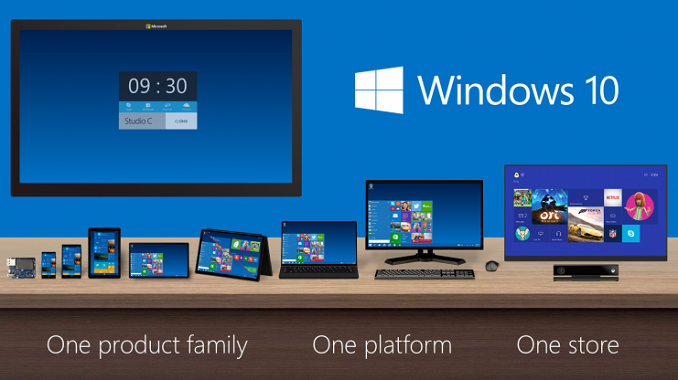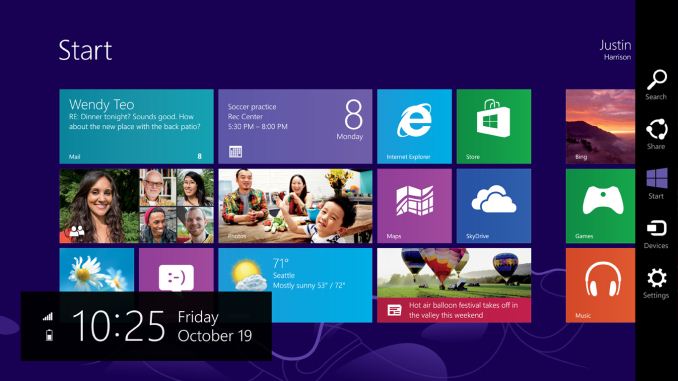Windows 10 Technical Preview First Impressions: The Return Of The Desktop
by Brett Howse on November 13, 2014 8:00 AM EST- Posted in
- Software
- Microsoft
- Windows 10

I’ve said this before, and I will reiterate it now. Windows 8, in general, is not perceived in a positive light. Not necessarily because of the lack of features, or even due to the touch first interface, but because from the start people did not buy into the paradigm. We can argue over why that was, and the specifics are likely different for every individual. But a big part of that was that Windows, which has had a familiar interface since Windows 95, had changed dramatically in look, feel, and general use. The traditional mouse and keyboard PC and notebook is a big part of the Windows user base, and especially at the beginning, Windows 8 did not cater to that crowd. While there were certainly improvements to the desktop, it was not enough to overcome the negative feelings of many users in regards to being productive on their PC. I say this as a fan of Windows 8.1, and I say this despite the positive review from this site. Windows 8 was an OS that worked, but had a steep learning curve that many people did not want to bother learning.
One of the biggest issues facing Windows 8 was just how much people liked Windows 7. Windows 7 was seen as the savior to Vista, and fixed many of its issues. But a lot of the initial problems with Vista were due to a major change in the driver model as well as the security model, which caused a lot of compatibility issues with older programs which expected administrator rights, as well as many hardware devices needed driver updates. With Windows 7, all of those changes were in the rear view mirror, allowing 7 to be a tweak of the overall UI and functionality rather than a rebuild of the OS from the ground up. With Windows 8, the move to touch first caused another dramatic upheaval. This time, rather than incompatible programs and hardware, we got a new Start Screen, a new runtime in WinRT, and a new app model with the Windows Store. For reasons that will never be made clear, the familiar start button was even removed, with the designers relying on hidden functions such as the hot corners to navigate around the OS with a mouse and keyboard. Luckily this change was reversed for Windows 8.1, with the start button returning, even if it still opened the Start Screen. With the Windows 8.1 Update, the system was made much more usable for a mouse and keyboard with the return of the menu bar to close apps, rather than dragging them down off the screen, and several other changes as well which brought the balance back somewhat to cover both touch interfaces as well as the mouse and keyboard.
 Windows 8 at launch in October 2012
Windows 8 at launch in October 2012
With Windows 8, Microsoft tried out an operating system which would work with a single interface across a breadth of hardware, from small form factor tablets, up to 30” monitor desktops. While they certainly succeeded in creating an interface that worked across all of those platforms, it was not ideally suited to any of them. With the tablet mode, the new Start Screen worked very well, and the charms menu and app switcher were fairly easy to use. But many of the settings and programs would be on the desktop, where touch only worked sparingly. Some desktop applications, such as Office, were created with a touch mode to increase the size of the onscreen elements, but overall the experience was subpar. Similarly, on the desktop, the touch interfaces were not ideal, and the hot corners certainly had issues especially on multi-monitor systems.
Windows 10 Technical Preview at launch
But now we come to Windows 10. Windows 10 is ditching the “One Interface to Rule them All” mentality, and moving to a more user friendly model of a single store across all platforms, and multiple interfaces to the same OS depending on the current usage model. We have not seen all of this in practice as of yet in the Technical Preview, but Microsoft has demonstrated their solution to this change in input mode with a feature they are calling Continuum.
The goal is that those that are on a keyboard and mouse based system will have the traditional start menu and desktop, with apps in windows, but if you are on a touch based device, or if you go on a 2-in-1 from keyboard to touch, the system will switch to the Windows 8 style start screen with full screen apps.
One of the keys to having this experience is an app model that allows a developer to target this different user interface paradigms. Microsoft’s solution to this is Universal Apps.











198 Comments
View All Comments
valnar - Monday, November 17, 2014 - link
I agree! And anyone who uses OneDrive without Boxcryptor is just asking for trouble. I would never use Microsoft's cloud service.Sabresiberian - Friday, November 14, 2014 - link
Excellent article Brett. It is very refreshing to read something about the Windows OS (or anything for that matter) that doesn't come from a negative or positive personal position as much as it comes from a realistic one.jmarchel - Friday, November 14, 2014 - link
There is one thing about Windows store (WinRT environment) that makes it unacceptable for me. It has no mechanism for average user for sideloading. Only corporations with domains are allowed to do so. I selected Windows in the past not only because it was popular but also because it was open. With WinRT being closed forcing developer to get Microsoft license and only allowing apps through the store I will not use this interface nor I will never write an application for it.ZenKiyoshi - Friday, November 14, 2014 - link
How about display scaling?Brett Howse - Friday, November 14, 2014 - link
So far I do not see any changes in regards to scaling over what was in 8.1. I was hoping for an option to force app scaling but nothing yet.kasakka - Friday, November 14, 2014 - link
I truly hope MS adds the polish Win10 needs before it gets released. Still too many legacy icons, tools that have those pesky non-resizable small list boxes (similar to the shit Nvidia Control Panel has) or look dating back to Win95. Likewise I hope they make notification center more aesthetically pleasing.You'd think MS would have the resources to employ an army of graphic artists to upgrade the stock icon libraries and another one to look over the many small usability issues that were plain and apparent even in the first preview.
jabber - Friday, November 14, 2014 - link
Dear MS can we please finally slip EMET as standard into Windows 10 and actually enable it by default.It's time folks were driven away from their 2003 shareware anyway.
Pointless adding in security if you switch it all off by default.
justausername - Friday, November 14, 2014 - link
Anyone know if Windows Server will get similar updates and changes?Brett Howse - Friday, November 14, 2014 - link
I have not had a chance to check out server yet, but this is the preview: http://blogs.technet.com/b/server-cloud/archive/20...phantom505 - Saturday, November 15, 2014 - link
Wow, "despite our good review on this site.." I like this site, have since 1998ish. HOWEVER, who the hell are you to make such a strange comment like "people did not want to bother learning." You can kiss me where the sun rarely shines.The interface is garbage. The search was garbage. Even 8.1 didn't really fix it sufficiently.
How about you respect your readers a little more, eh?